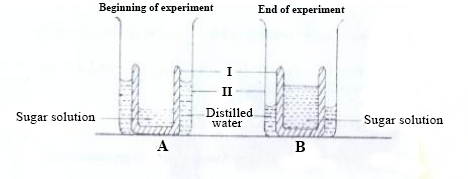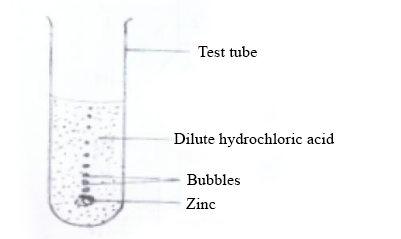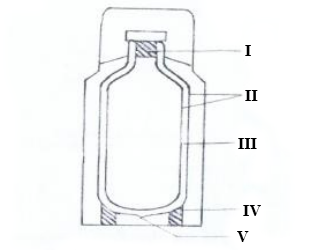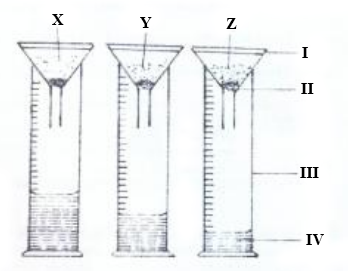1.
The S.I unit of temperature is
Candela
Degree Celsius
Joule
Kelvin
2.
Air is an example of
gas in gas mixture.
liquid in liquid mixture.
solid in liquid mixture.
solid in solid mixture.
3.
Which of the following activities are involved in the rearing of tilapia?
I. Feeding of fish
II. Pond stocking
III. Pest control
I and II only
I and III only
II and III only
I, II and III
4.
The part of the flower that contains nectar is called
anther.
petal.
ovary.
sepal.
5.
Which of the following methods protects pure iron from rusting by coating with zinc?
Alloying
Galvanizing
Greasing
Painting
6.
Leaching of nutrients from the soil leads to soil
acidity.
alkalinity.
erosion.
porosity.
7.
The hereditary material that is passed on from parents to offspring is known as
gene.
sperm.
red blood cell.
white blood cell.
8.
The solar system is made up of the
earth, moon and stars.
sun, comets and meteors.
sun, earth and moon.
sun, planets and other heavenly bodies.
9.
The type of management system which allows farm animals to roam about freely is known as
extensive system.
intensive system.
semi-extensive system.
semi-intensive system.
10.
External respiration in living organisms is also known as
aerobic respiration.
anaerobic respiration.
gaseous respiration.
tissue respiration.
11.
A rigid bar which is capable of turning about a fixed point is a/an
inclined plane.
lever.
screw.
wheel and axle.
12.
A positively charged ion is called
anion.
cation.
neutron.
proton.
13.
One way of ensuring that organisms are not endangered is to
allow them to be hunted.
allow their predators to outnumber them.
protect their habitats.
pollute their habitats.
14.
A good thermometer liquid must
be colourless.
boil at 100oC and freeze at 0oC.
cling to the walls of the glass.
expand evenly and regularly.
15.
Which of the following metals will produce a gas when placed in lime juice?
Copper
Lead
Magnesium
Silver
16.
The physical property of a soil which is determined by the feel method is soil
structure.
temperature.
texture.
water.
17.
The reason why gaps are left in the joints of railway lines is to allow for
cooling.
contraction.
expansion.
maintenance.
18.
Which of the following effects are caused by rusting?
I. Loss of strength
II. Loss of structure
III. Loss of electrical conductivity
I and II only
I and III only
II and III only
I, II and III
19.
Leguminous crops may often be cultivated to add
carbon to the soil.
nitrogen to the soil.
protein to the soil.
potassium to the soil.
20.
A place where an organism can live and interbreed successfully is called
community.
ecosystem.
environment.
habitat.
21.
Which of the following methods of treating water makes it soft?
Addition of alum
Addition of sodium carbonate
Chlorination
Filtration
22.
Dehusking and shelling are both activities carried out in the processing of
cowpea.
groundnut.
maize.
sorghum.
23.
Typhoid fever is transmitted through
contact with contaminated skin wounds.
eating contaminated food.
eating uncooked food.
drinking treated water.
24.
One advantage of friction is that it
enables cutting tools to be sharpened.
increases the efficiency of machines.
produces a lot of heat in machines.
wears off the sole of shoes.
25.
Sickle is a farm tool used for
harvesting rice.
trimming hedges.
transplanting seedlings.
watering crops.
26.
One characteristics of the image formed in a pin-hole camera is that the image is
diminished.
magnified.
upright.
virtual.
27.
Transplanting of seedlings is usually done in the evening because
darkness promotes rapid growth
pest attack is minimal.
transpiration is minimal.
seedlings require less nutrients.
28.
Which of the following statements about molecules is/are correct? Molecules
I. are chemically combined group of atoms
II. are physically combined group of atoms
III. can exist on their own
I only
II only
I and III only
I, II and III
29.
Fruits which are dispersed by wind are likely to be
dry.
hairy.
juicy.
sticky.
30.
Which of the following materials allows electric current to pass through easily?
Aluminium
Carbon
Glass
Water
31.
Water contains two elements, hydrogen and oxygen, in the ratio of
1:2
1:3
2:1
3:1
32.
In the digestive system of ruminants, vitamins are synthesized in the
abomasum.
omasum.
reticulum.
rumen
33.
The best way of protecting oneself from high blood pressure is to
consume alcoholic drinks.
eat high carbohydrate diet.
engage in smoking.
exercise regularly.
34.
The property of metals which makes them to be easily drawn into thin wires is known as
conductivity.
ductility.
malleability.
resistivity.
35.
An atom of an element is represented as 1327 X. How many neutrons are in the nucleus of the atom?
13
14
27
40
36.
Viable seeds are ones that
are able to germinate under suitable conditions.
are eaten by animals after planting.
contain a lot of oil.
have hard seed coat.
37.
Which of the following processes can occur at all temperatures?
Boiling
Evaporation
Melting
Sublimation
38.
Which of the following human activities maintains the carbon cycle?
Bush burning
Felling of trees
Release of fumes from factories
Replanting of trees felled as timber
39.
The farming system which involves the growing of one type of crop on the same piece of land every season is known as
mixed cropping.
mixed farming.
monocropping.
monoculture.
40.
The presence of chlorophyll in green plants is a necessary condition for photosynthesis because it
absorbs oxygen.
absorbs solar energy.
produces carbon dioxide.
produces water vapour.
(a)
The diagrams below are illustrations of an experiment to demonstrate a biological principle.
Study the diagrams carefully and answer the questions that follow.

(i)
Name the parts labelled I and II.
(ii)
State two differences between the set-ups A and B.
(iii)
What is the role played by the part labelled I in the experiment?
(iv)
Name the biological principle being demonstrated in this experiment.
(v)
State one way in which plants benefits from the principle named in (iv).
(vi)
State one way in which animals benefit from the principle named in (iv).
(b)
In an experiment to investigate the reactivity of zinc, a piece of the metal was dropped into a test tube containing dilute hydrochloric acid. The experiment set-up is illustrated below.

Study the set-up carefully and answer the questions that follow.
(i)
Write a balanced chemical equation for the reaction that occurred in the experiment.
(ii)
Name the gas evolved.
(iii)
List two metals which can react in a similar way as the zinc.
(iv)
List two metals which cannot react in a similar way as the zinc.
(v)
Name two glass apparatus which could have been used instead of the test tube.
(c)
The diagram below is an illustration of a thermos flask.

Study the diagram carefully and answer the questions that follow.
(i)
Name the parts labelled I, II, III, IV and V.
(ii)
How does the device minimize heat loss or gain through
(α)
conduction?
(β)
convection?
(γ)
radiation?
(iii)
State one use of the thermos flask.
(d)
The diagrams below illustrate an experimental set-up on a physical property of soil using three soil types X, Y and Z.

Study the set-up carefully and answer the questions that follow:
(i)
Name the parts of the set-up labelled I, II, III and IV.
(ii)
Which of the three soil types has the
(α)
highest water holding capacity?
(β)
least water holding capacity?
(iii)
Name each of the three soil types X, Y and Z.
(iv)
Suggest a suitable title for the experiment.
(a)
List the three particles which make up matter.
(b)
State four hereditary features in humans.
(c)
State the energy transformation that takes place in each of the following activities:
(i)
dry cell in use;
(ii)
solar panel in use;
(iii)
electric stove in use;
(iv)
hammering of a piece of metal.
(d)
State two ways each in which each of the following cultural practices is important in vegetable production:
(i)
staking;
(ii)
pruning.
(a)
(i)
What is indiscriminate sex?
(ii)
Give two reasons why teenagers indulge in indiscriminate sex.
(b)
Name two sources each of
(i)
natural light;
(ii)
artificial light.
(c)
State three ways in which soil texture is important in crop production.
(d)
Write down the systematic name of each of the following chemical compounds:
(i)
FeS;
(ii)
CO;
(iii)
Cu2O;
(iv)
NaOH.
(a)
(i)
What do the symbols L, N and E represent in an electric plug?
(ii)
What is the function of the fuse box in household electrical wiring?
(b)
Mention four classes of insect pest based on their feeding habits.
(c)
Classify the first four elements of the periodic table as metals and non- metals.
(d)
Name the three types of blood vessels in humans.
a)
i)
State the difference between organic fertilizer and inorganic fertilizer.
ii)
State two effects of inorganic fertilizer on the environment.
b)
Classify the following substances as acids or bases.
i)
unripe lemon juice;
ii)
wood ash;
iii)
liquid in a car battery;
iv)
bicarbonate of soda.
c)
i)
What is a fruit?
ii)
State two differences between a fruit and a seed.
d)
State the effect of heat on each of the following substances:
i)
plastics;
ii)
alcohol;
iii)
metal rod.
a)
Classify the following chemical substances basd on their uses under the headings as shown in the table below: Milk of magnesia, alcohol, paracetamol, sodium hydroxide, N.P.K.
| Agricultural | Industry | Medicine |
b)
State one use each of the following instruments used in the study of the weather:
i)
rain gauge;
ii)
hygrometer;
iii)
anemomoter.
c)
i)
Name two types of transistors.
ii)
Draw and label the circuit symbols of the transistors named in (i).
d)
State three reasons why vegetable farming is important.